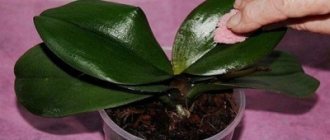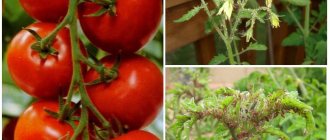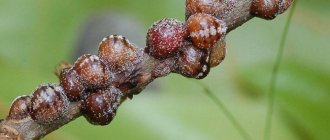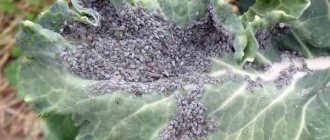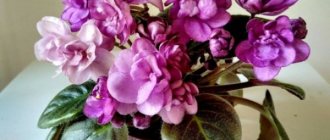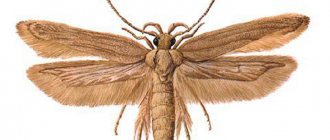Where can aphids appear on orchids?
Naturally, this harmful insect is not initially found in apartments, but it can get into the room in several ways. They are obvious:
- any small parasite can be carried into the house by the wind through a window or balcony opening;
- you can bring the pest yourself on clothes or shoes;
- traditional carriers of harmful insects are pets after a walk;
- it is quite possible to buy an already infected plant in a store;
- aphids can spread to the orchid from neighboring indoor plants;
- If you collect soil on the street and do not disinfect it, the likelihood of aphids getting into the apartment along with the substrate is very high.
The most effective fight against this parasite is carried out at the initial stage of infection. But it is precisely at this time that the aphid, when its colony is still small, is difficult to notice with the naked eye.
Methods for killing aphids on an orchid
If aphids appear on an orchid, then you need to act immediately - wash the plant under a warm shower from sticky honeydew using a solution of laundry soap and isolate it separately from other specimens in the collection. Then decide how to get rid of insects - using folk or chemical means.
Folk recipes
To prevent aphid attacks, place pots with ordinary indoor pelargonium next to the orchids or sprinkle fresh tea leaves on top of the substrate - the insect does not like their smell.
If the infestation is minor, prepare a remedy for aphids on orchids and spray it on plants affected by aphids:
- celandine infusion - a bunch of fresh or dried leaves along with stems are infused in 1 liter of boiled water for 1-2 days;
- infusion of citrus peels - 200–300 g of lemon or orange peels, pour 1 liter of boiling water and infuse in a dark and warm corner for 3 days;
- flea shampoo - dissolve 1 cap in 0.5 liters of water;
- tobacco infusion - use the contents of cigarettes, infuse in 1 liter of water for 24 hours;
- onion infusion - finely chop a medium-sized onion and pour 1 liter of boiling water, seal tightly and leave for about 7-8 hours.
Chemicals
They resort to chemicals when there is already a large population of pests on orchids. How to treat an orchid against aphids? They are destroyed by repeated spraying with insecticides:
- contact action, entering the insect's body through the skin - permethrin, neoron, Roxion D, Neudosan Neu Blattlausfrei, Schadlingsfrei;
- enteric contact, absorbed along with food from the surface of the plant - fitoverm, inta-vir, actara, arrivo, actellik;
- systemic action, penetrating into plant cells and eaten with juice by aphids - Bi 58, Lizetan-Plus-Zierpflanzenspray and others.
It should be noted that during re-treatment it is necessary to use another agent, since aphids quickly get used to the chemical and acquire stable immunity to it. Particular attention should be paid to atomizing preparations that are sold in spray form. The product located inside the can in a compressed state at a short distance from the flower during spraying greatly supercools the surface of the leaves and causes damage to the tissues. Usually, in the instructions for the spray, the manufacturer indicates how far from the plant the sprayer should be held during treatment.
Insect species
There are about 4,000 species of aphids in nature. The main ones:
- Brown. She is also called the ashtray. He especially loves pears, but he won’t refuse orchids either. Able to survive in any climate.
- Green. This is also mainly a garden pest that affects fruit trees, but if you have an orchid growing in your dacha, prepare to encounter this species as well.
- Black. It looks smaller than the others, but it can cause damage much faster and more due to the large number of colonies.
- Yellow. A relatively harmless and primitive species, it rarely migrates; only one generation of insects is born per season.
- Red. It severely affects the roots of the plant, forming growths on them, which then crack and rot.
- White. The most common and dangerous because it is difficult to notice even in large numbers. The species constantly migrates, so it can be found almost everywhere.
What does the affected plant look like?
If the plant is severely affected, it is immediately noticeable:
- leaves become soft and limp;
- at the final stage of infection they begin to curl;
- the bud also becomes sluggish, eventually dries and falls off;
- the flower stalks also dry out;
- The stem begins to noticeably darken.
Important! At the earliest stage of infection, a sticky coating appears on the underside of the leaves. Therefore, the orchid must be examined regularly.
Aphids begin to attack the plant from the leaves. Then the insect gradually moves onto the stem, peduncles and, finally, onto the flowers themselves. Flower juice is the most desirable delicacy for them. When feeding, aphids not only draw juices from the plant, depleting it, but the insects’ saliva secretes poison that can destroy the orchid.
Aphids on an orchid: how to quickly get rid of them, effective ways to combat the pest
05.05.2019 Victor Karseko
There are several hundred species of this pest. The most common aphids found on an orchid are brown, green, red, black, yellow and white. The parasite sucks nutrients from the plant, injecting poison into it. Over time, the flower becomes incapable of photosynthesis and dies.
It is impossible not to notice the effect of aphids on an orchid. The plant quickly loses its healthy appearance. First, the pest attacks the leaves, then the stem of the plant, and then switches to buds and flowers. Since the insect's numbers are growing rapidly, it can be easily spotted by examining the leaves.
Signs of aphids on an orchid
The affected flower has the following symptoms:
- flowers fall;
- ripe inflorescences do not bloom;
- leaves curl and turn yellow;
- spots appear on the stem;
- stickiness of the flower.
Small scales are also visible on the leaves - the covering shed by the pest during molting. The sticky liquid that appears on an aphid-infested orchid can attract ants. It is necessary to regularly inspect the plant for preventive purposes.
Reasons for the appearance of aphids on an orchid
The presence of an insect on a plant indicates improper care for it. It is necessary that the climate in which the flower is kept is not dry. Improper watering and lack of microelements can also cause damage. In addition, you can infect an orchid with aphids from other plants, from a flower shop, or by using soil that already contains the pest. Only special soil should be used.
If the soil has become a source of aphids, the roots of the plant should be carefully washed and treated with an insecticide. Calcine the soil in the oven or put it in the freezer for several days, or better yet, replace it with a new one. Fresh soil can also be disinfected for preventive purposes.
How to get rid of white aphids?
Fortunately, there are quite a few methods and means to combat these pests. You just need to not be too lazy to use them on time.
Mechanical method
To combat aphids, it is most effective to use appropriate preparations - there are quite a lot of them in stores. As a rule, if the gardener has not yet encountered this problem, there are no such remedies at hand. And help should be provided to the plant as quickly as possible.
In such cases, a simple method of pest control, called mechanical, will help. The following actions must be taken:
- collect spotted individuals and their larvae by hand and destroy them;
- rinse the flower thoroughly with warm water;
- It is advisable to use a soap solution.
Important! Water should not get into the axils of the leaves. It stagnates there and causes the plant to rot, which is especially attractive to pests.
After the procedure, the soil must also be disinfected. To do this, you need to lightly stir it and pour it with a solution of potassium permanganate.
Biological drugs
The latest invention to combat such pests. Insects are destroyed by a special type of bacteria, although not immediately, but gradually, over approximately one week.
The advantages of this method include:
- availability of spraying treatment;
- protective properties last up to 2 weeks;
- These drugs do not cause any harm to humans or pets.
Important! There is one drawback to biological drugs. Do not allow preparations of this type to come into direct contact with the flower: it may die.
Spraying is carried out from the bottom up starting from the leaves. The leaves are treated on both sides, and only then the solution is applied to the stem.
The most effective and widespread biological products include:
- Fitoverm - its effect begins after approximately 2 days and lasts up to 3 weeks;
- Entobacterin - starts working after 5 days, is especially effective at temperatures around +30 degrees;
- Confidor - the drug is produced in Germany and is highly effective; its effectiveness is noticeable a week after treatment;
- Akarin - also shows good results after a week, but does not work on all types of aphids.
It is advisable to duplicate the initial treatment after 2-3 weeks, then the result will be better. It is only important to strictly follow the instructions for use of the drug.
Chemicals
They are recommended for use in cases of severe infection. For greater effectiveness, solutions of this type should be used at intervals of 2 weeks.
Important! It is advisable to use the drugs alternately. They quickly become addictive to insects and cease to have a detrimental effect on them.
When treating plants with chemicals, be sure to use rubber gloves and a respirator. The procedure must be carried out outdoors.
There are several available and effective drugs:
- Aktara - acts on the nerve endings of the insect and leads to its almost instant death;
- Actellik - actively acts not only on the plant, but also in the soil, begins to destroy insects already in the process of spraying;
- Spark is one of the rare chemicals that is virtually harmless to humans and pets;
- Intavir disrupts the functioning of the nervous system of pests, causing them to quickly die.
According to the method of influencing parasites, chemicals are divided into several groups:
- intestinal enter the insect’s body through the juice of the treated plant;
- systemic ones kill aphids when they enter the intestines and directly onto the skin;
- contact ones act by contacting the insect itself.
It is believed that systemic and intestinal remedies are most effective. Contact ones are recommended to be used at the initial stage of infection.
How to fight at home?
When aphids are detected on an orchid, the infected flower is first isolated from other indoor plants, since the parasites multiply very quickly and move to other individuals.
Initially, you can try to cure a sick orchid with folk recipes for aphids , since they consist of plant components that are not harmful to humans and domestic animals. But if such methods prove powerless in controlling pests, at the next stage you will have to resort to the use of insecticides and other chemically active substances.
Let's consider all the ways to combat aphids on indoor plants.
Mechanical removal
Killing aphids involves removing the pests with your fingers or washing them off the plant with a stream of warm water in the shower. The orchid substrate should also be washed well, disinfected with a weak solution of potassium permanganate , and then dried thoroughly.
Use of biological products
Biological products appeared not so long ago; these are new generation products for controlling pests of indoor plants. But they have already proven themselves very well and are recognized as quite effective.
The impact on aphids occurs due to infection with bacteria and fungi, which poison the pests with their poisons, slowing down their development and reproduction. The effect of using biological products is visible already in the first week, and their protective properties last for another two weeks. Another good thing about these products is that they can be used directly indoors.
The most effective remedies for aphids on orchids are:
- Fitoverm.
- Arrow.
- Entobacterin.
- Jaguar.
- Confidor.
Traditional methods
Soap solution - its antiseptic and disinfecting effect has a detrimental effect on aphids. To treat an orchid against parasites, ordinary laundry soap is also perfect, which can be rubbed on a coarse grater into a bowl of warm water, and then treated with such a soap solution on all the leaves and the stem of the flower. Dishwashing liquid will also serve this purpose perfectly.- Citrus water – an excellent remedy for the spread of aphids on flowers.
To do this you need:- take a handful of any citrus peels (lemon, orange, tangerine, grapefruit);
pour a glass of boiling water over it;
- leave for about 3 days.
- Onion water – will help save the flower with a strong spread of aphids.
To prepare the product:- take 1 large onion and chop it into a paste;
pour boiling water over it and infuse for 6 hours;
- the cooled solution must be filtered through cheesecloth;
- then spray the orchid with it several times a day for about 3-4 days.
- Essential oils – have a good effect in the fight against parasites. For example, you can take:
- 10-15 drops of tea tree oil or peppermint essential oil;
dissolve them in a large 300 gram glass of water;
- treat the leaves and trunk of the orchid with the resulting solution.
The plant is sprayed with the resulting infusion every 4-5 hours. To enhance the effect, soaked peels of their infusion can be placed on the soil around the flower.
Onion water consists of disinfecting components and has a very pungent odor that will force aphids to leave the plant.
This product can be used once every 2 weeks.
Products based on essential oils are not recommended for use at high humidity and temperatures above 25˚C.
You can find out more about the most effective folk remedies for aphids here.
Chemicals
Chemicals for plants should be used only in case of severe aphid infestation, when other methods have not helped to cope with the pest. The dosage of each drug must be calculated strictly according to the instructions from the manufacturer.
Insecticides based on the nature of their effect on aphids are divided into 3 groups:
Contact - Spruzit-Af, Permethrin, Roxion-D, Neoron, affect the skin of parasites.- Intestinal - Fitoverm, Aktara, Aktellik, Inta-Vir, Arriva, enter the body of insects through the intestines.
- Systemic - Methylmercaptophos, Bi-58, Phosphomite, act instantly, destroying both adults and their larvae and eggs, and help prevent re-damage to the flower. The drugs are absorbed by the orchid's root system, then enter its trunk and leaves, making the juice poisonous to aphids.
All these products need to be alternated with each other and used no more than 3 times in a row, since aphids very quickly get used to the effects of chemicals and they may stop working on them.
Processing of the plant should be carried out in the fresh air with gloves and a respirator. Do not allow poisons to come into contact with eyes or bare skin.
The reader may also be interested in the following articles about how to fight aphids on various plants:
- on pepper;
- on roses;
- on fruit trees;
- on cucumbers;
- on currants;
- on indoor and garden plants.
Is it possible to fight pests with folk remedies?
There are a lot of folk remedies for fighting aphids, and most of them are quite affordable. However, at a late stage of the lesion they are not always effective.
Here are some of them:
- Garlic. The bulbs are crushed together with the husks and dissolved in warm soapy water, the product is infused for a day, after which it is sprayed.
- White mustard. 10 g of mustard is dissolved in 1 liter of warm water and left for two days, the resulting concentrate is diluted with water in a ratio of 4:1.
- Tomato tops. 0.5 kg of tops is poured into 1 liter of water, boiled for 30 minutes and, after cooling, sprayed on the affected plant with added soap.
- Nettle. It is crushed, filled with water and infused for about a day.
- Bulb onions. It is cut together with the husk, filled with water and left for about 8 hours, before use it is filtered and then sprayed on the orchids.
- Citrus peels. They are also filled with water, left for 3 days and sprayed several times.
- Alcohol. The soap solution is mixed with alcohol in equal proportions; 15 minutes after the spraying procedure, the leaves are washed with water so that they do not burn.
Some gardeners successfully fight aphids using the medicine Trichopolum. The tablet is dissolved in water and sprayed on the plants. You can bury such a tablet in the ground before planting an orchid; it is believed that this will be a preventive measure against many pests.
Fighting methods
Traditional methods
Aphids are a serious enemy for indoor orchids, and if appropriate measures are not taken in time, the flower can be lost.
As soon as the pest is detected, immediately isolate the orchid from other indoor plants to avoid damage. Rinse the leaves immediately with warm water, and simply remove all flowers and buds.
Traditional methods will bring the greatest effect in the first stages, when pests have been detected.
One such method is treating the plant with a soap solution. To prepare it, you should use dark laundry soap. Grate it and make a solution at the rate of: 1 tbsp. l. soap per 1 liter of water. After the soap is well dissolved in water, the resulting product can be applied to the leaves using a sponge. Instead of soap, dishwashing detergent is suitable.
The leaves are also wiped with citrus infusion, which is infused for three days. To prepare it, take 100 g of lemon, tangerine or orange peels and add 1 liter of water.
Onion infusion is prepared simply: pour chopped onion with water.
Rubbing with solutions containing essential oils of mint and tea tree gives a good effect. However, there are limitations in this case. This product should not be used at temperatures above +25 °C, or if the room has high humidity.
You can also wipe the leaves with rosehip infusion.
When using traditional methods, you first need to remove all affected areas and treat the leaves with prepared solutions.
Biological products and insecticides
If you have used folk remedies and did not get the desired result, then you should switch to “chemistry”. Such preparations are widely available in specialized flower shops. When using, you should strictly follow the instructions.
There are different groups of drugs. There are those that penetrate through the skin or into the mouth of the insect. Some penetrate into the sap of the plant, making it poisonous.
When using such products, you should take precautions, as toxic substances can cause significant harm to both your health and the health of your pet.
How to treat the soil and roots?
It is recommended to periodically, even for preventive purposes, water the plant with a solution of potassium permanganate, but if it becomes infected, this must be done. You can water the soil in the pot with a solution of biological preparations, but you should not treat the roots with chemicals. An infusion of onion peels helps a lot.
It happens that when orchids are transplanted, characteristic growths caused by aphid infestation are found on the roots. They must be removed immediately and the entire plant disinfected.
Preventing the spread of aphids
There are several simple steps that will help prevent aphid infestations:
- the orchid should be watered regularly, once a week, no more and no less;
- dry soil attracts aphids, but also abundant moisture on the leaves - do not allow either one or the other;
- excess or lack of fertilizers significantly weakens the plant’s immunity - watch this and follow the dosage and frequency indicated on the label;
- pots must be disinfected before use;
- soil, even purchased in a store, should be kept in the freezer or oven for a while before planting: this procedure will destroy possible pests and their larvae.

